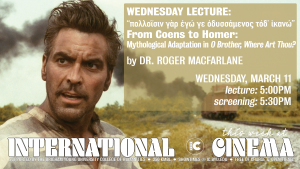O Brother Where Art Thou Parallels to the Odyssey


But, before jumping into epic poetry at last calendar week'due south IC lecture, Macfarlane talked about some other text that O Brother, Where Art K? is adapting: Preston Sturges's Sullivan'due south Travels (1941). Sullivan'southward Travels is ane of the great comedies from the classical Hollywood period. Information technology follows a director of second charge per unit comedies who is trying to convince his producers to permit him make a film of social importance. They claim that he doesn't know suffering so Sullivan sets out on a journey to learn what life is really like outside of his protected, affluent bubble. The film he wants to make is titled, O Brother, Where Art Thou? Macfarlane pointed to i instance, also the title, which serve as points of contact in the Coen Brothers' film to Sturges'southward: the picture palace. In Sullivan'south Travels , one of the climactic scenes is of a grouping of prisoners brought into a church to watch a film. This prototype of prisoners entering a darkened theater is mirrored in the Coen Brothers' film when a chain gang shuffles in to watch a pic in an actual theater. This visual match clues viewers into understanding O Brother, Where Art Thou? through the themes of Sullivan's Travels— a film which Macfarlane highly recommended viewers besides see this calendar week at the International Movie house.
At that place are a few gimmes for reading O Blood brother, Where Art One thousand? as an adaptation of The Odyssey . Firstly the character names overlap. George Clooney plays our main character named Ulysses Everett McGill has Odysseus'due south Latin proper noun, and the two characters are very similar. Penny Wharvey-McGill (Holly Hunter) also mirrors Penelope. Others diverge quite a flake though, such as Menelaus "Pappy" O'Daniel who does not fit with the Menelaus character in The Odyssey . John Goodman's character wears an eyepatch and is very like to the cyclops, Polyphemus, they are even maimed in similar means with burning pieces of wood. The sirens are too a straightforward adaptation with singing women luring the men away from their quest and leading them to be killed.
While many of these elements line upward nicely, Macfarlane observed that the film also contains a number of less direct adaptations. Such as, "why is there a bust of Homer in the groundwork of the 'Pappy' O'Daniel character introduction?" and "Who is the blind railroad man? … He matches Tiresias visually but non thematically."
One less obvious accommodation of Homer is the use of the song "Man of Constant Sorrow" sung by Ulysses and his pals in the picture. The song's title is a reference to Odysseus'south name, which is a pun on the verb in Greek meaning "to endure" or "to cause suffering." Additionally, during The Odyssey , Tiresias tells Odysseus that before he tin can find residual, he needs to carry an oar in land far enough to discover a people who do non recognize its utilize. There he needs to institute a cult of Poseidon. Macfarlane read this instance every bit the referent for the music in the film generally, because the music is all from outside of Mississippi and more akin to the music of Appalachia.

Source: https://ic.byu.edu/from-coens-to-homer-mythological-adaptation-in-o-brother-where-art-thou/
0 Response to "O Brother Where Art Thou Parallels to the Odyssey"
Post a Comment